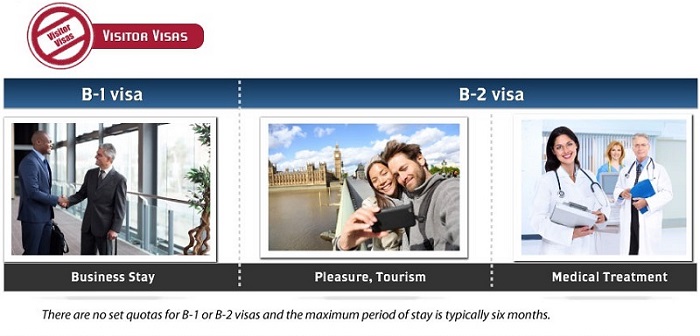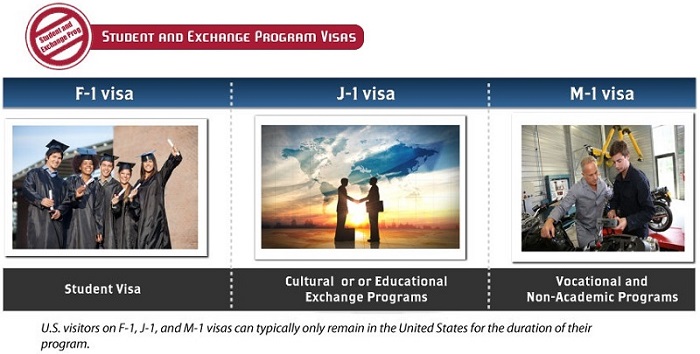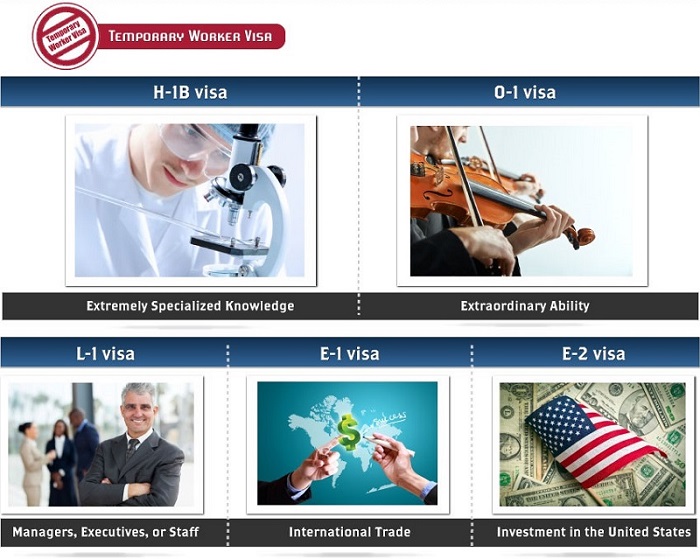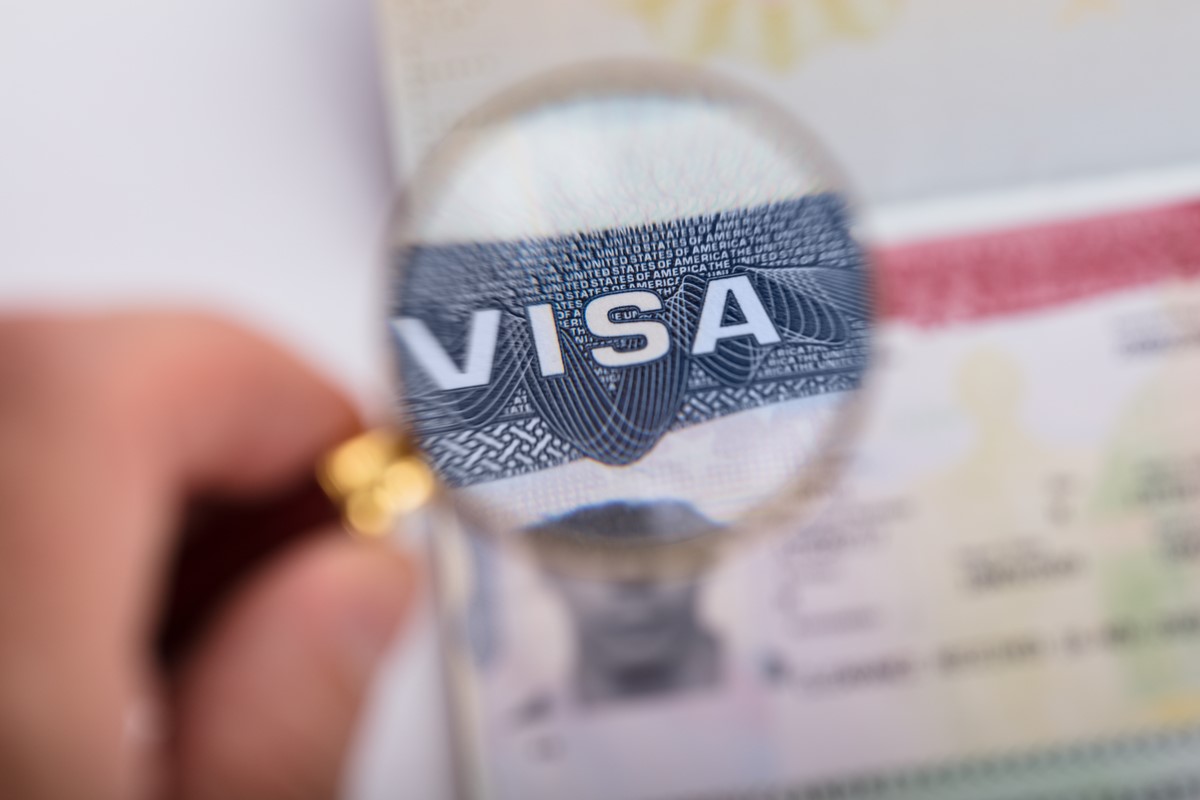What is a Nonimmigrant Visa?
Millions of people enter the United States on different types of U.S. visas each year. There are two general types of U.S. visas: nonimmigrant visas and immigrant visas. Nonimmigrant visas are travel documents that enable foreigners to travel to the United States for a finite temporary period of time. An immigrant visa, on the other hand, is a legal classification that enables the visa holder to permanently reside in the U.S. The type of non-immigrant or immigrant visa that applicants should seek depends on their background and why they wish to enter the United States. Below is a description of the most common nonimmigrant visas.
Visitor Visa

There are several types of nonimmigrant visas that enable foreigners to visit the United States for a temporary stay. Nonimmigrant visitor visas include the B-1 and B-2 visa. B-1 visas are business visitor visas that enable foreign workers to enter the United States for a business stay.
- B-1 visas are most suitable for those traveling to the United States to settle an estate, negotiate a business contract, meet with business associates, or attend meetings.
- B-2 visas are visitor visas for those traveling to the United States for pleasure, tourism, or medical treatment.
There are no set quotas for B-1 or B-2 visas and the maximum period of stay is typically six months.
Those applying for visitor visas must file the DS-160 Online Nonimmigrant Visa Application form with the U.S. Department of State. Applicants must be interviewed by a U.S. embassy or consulate and have a current photograph and valid passport. Those seeking visitor visas must also prove that they do not wish to permanently reside in the United States and plan to return to their native country after their visit. This is called the establishment of non-immigrant intent, and must be proved during the applicant’s consular interview.
Visa Waiver Program
The visa waiver program (VWP) enables foreign residents from eligible countries to visit the United States for tourism or business, for 90 days or less, without a B-1 or B-2 visa. There are currently 37 countries that are eligible for the VWP.
Andorra, Australia, Austria, Belgium, Brunei, Czech Republic, Denmark, Estonia, Finland, France, Germany, Greece, Hungary, Iceland, Ireland, Italy, Japan, Latvia, Liechtenstein, Lithuania, Luxembourg, Malta, Monaco, the Netherlands, New Zealand, Norway, Portugal, San Marino, Singapore, Slovakia, Slovenia, South Korea, Spain, Sweden, Switzerland, Taiwan, and the United Kingdom.
Student and Exchange Program Visas

The United States grants F-1, J-1, and M-1 nonimmigrant visas that enable foreign residents to come to the United States as student and exchange visitors. U.S. visitors on F-1, J-1, and M-1 visas can typically only remain in the United States for the duration of their program. However, extensions of stay may be granted to these visa holders.
F-1 student visas are reserved for those who want to enter the United States to study at an accredited high school, college, university, or language institute. F-1 visa holders are required to be full-time students with a full course load during every educational term. F-1 visa applicants must also prove that they have ties to their home country that will serve as motivation for the visa holder to return home after their program is complete. Such ties to home can include the existence of family owned property, job prospects, or membership in a professional organization in their home country.
J-1 exchange visitor visas are for those who participate in cultural or educational exchange programs. Such programs include teacher, intern, trainee, professor, and au pair programs.
M-1 visas are for those who enroll in vocational and nonacademic programs.
Applicants must first be accepted to a qualified program to be eligible for an F-1, J-1, or M-1 visa. Applicants must enroll with the Student and Exchange Visitor Information System (SEVIS), a database that keeps track of all student and exchange visitors in the United States.
Interviews at the U.S. consulate or embassy located in the applicant’s home country are required for those seeking an F-1, J-1, or M-1 visa. The applicants must prove their nonimmigrant intent during this consular interview and their intention of returning to their home country after their visa’s expiration. Applicants are required to provide the DS-160 Nonimmigrant Visa Application, their passport, and photograph, along with any nonimmigrant visitor eligibility forms that relate to their specific program. In general, exchange visa applicants must also provide educational documents (such as diplomas and SAT or GRE scores) and financial records proving that they will be able to cover all of their costs while living in the United States.
Dependents of those with student and exchange program visas are permitted to enter the United States on F-2, J-2, or M-2 visas. Dependents can include spouses and unmarried children under 21 years of age.
Temporary Worker Visa

Foreign residents seeking U.S. employment for a set period of time may be eligible to move to the United States using a non-immigrant temporary worker visa. The companies that seek the employment of foreign workers usually file the petitions for their worker’s visa. The particular visa that the employee is eligible for depends on the nature of their stay and occupation.
H-1B visas are reserved for those whose professions require extremely specialized knowledge. The H-1B visa category includes a broad spectrum of professions, such as fashion models, government to government researchers, and Department of Defense coproduction project workers.
O-1 visas are for individuals with extraordinary ability or achievement in such fields as the arts, sciences, athletics, education, business, and entertainment.
O-2 visas are for workers who accompany O-1 visa holders to a specific performance or job event.
L-1 visas are for managers, executives, or staff with specialized knowledge who transfer from an overseas office to the U.S. branch of a U.S. company.
E-1 visas are for workers from treaty countries who enter the United States to engage in international trade. Treaty countries are those with which the United States maintains a navigation or commerce treaty.
E-2 visas are for individuals from treaty countries who have made considerable investments in the United States.
E-1 Treaty Countries
Argentina, Australia, Austria, Belgium, Bolivia, Bosnia and Herzegovina, Brunei, Canada, Chile, China (Taiwan), Colombia, Costa Rica, Croatia, Denmark, Estonia, Ethiopia, Finland, France, Germany, Greece, Honduras, Iran, Ireland, Israel, Italy, Japan, Jordan, Korea (South), Latvia, Liberia, Luxembourg, Macedonia (FYROM), Mexico, Montenegro, Netherlands, Norway, Oman, Pakistan, Paraguay, Philippines, Poland, Serbia, Singapore, Slovenia, Spain, Suriname, Sweden, Switzerland, Thailand, Togo, Turkey, United Kingdom, Yugoslavia
E-2 Treaty Countries
Albania, Argentina, Armenia, Australia, Austria, Azerbaijan, Bahrain, Bangladesh, Belgium, Bolivia, Bosnia and Herzegovina, Brunei, Bulgaria, Cameroon, Canada, Chile, China (Taiwan), Colombia, Congo (Brazzaville), Congo (Kinshasa), Costa Rica, Croatia, Czech Republic, Denmark, Ecuador, Egypt, Estonia, Ethiopia, Finland, France, Georgia, Germany, Grenada, Honduras, Iran, Ireland, Italy, Jamaica, Japan, Jordan, Kazakhstan, Korea (South), Kosovo, Kyrgyzstan, Latvia, Liberia, Lithuania, Luxembourg, Macedonia (FYROM), Mexico, Moldova, Mongolia, Montenegro, Morocco, Netherlands, Norway, Oman, Pakistan, Panama, Paraguay, Philippines, Poland, Romania, Serbia, Senegal, Singapore, Slovak Republic, Slovenia, Spain, Sri Lanka, Suriname, Sweden, Switzerland, Thailand, Togo, Trinidad & Tobago, Tunisia, Turkey, Ukraine, United Kingdom, Yugoslavia
Although the applications can vary depending on the particular visa category, all temporary worker visa applicants follow the same general application process. Employers hiring temporary visa workers must have an approved I-129 non-immigrant worker petition from USCIS. Temporary workers must provide the nonimmigrant electronic visa form DS-160 to the U.S. embassy or consulate within their location of permanent residence. Temporary visa applicants are required to undergo interviews at the U.S. embassy or consulate closest to their place of residence. Several temporary worker visa categories require labor certification from the Department of Labor to demonstrate that the visa applicant will be paid a prevailing wage.
A prevailing wage is the compensation that a similarly employed U.S. worker would be paid for the same job. Ensuring that foreign workers are fairly paid helps ensure that no U.S. workers will be displaced by foreign workers receiving a lesser wage. The prevailing wage requirement also prevents the foreign worker from exploitation and being underpaid. Although it varies depending on the specific category, the initial period of authorized stay for temporary visa workers generally lasts from one to three years. Certain visa categories have set periods of length for the visa (H-1Bs and L-1s) and certain visa types are renewable indefinitely (O-1s and Es).







